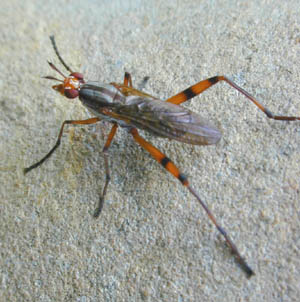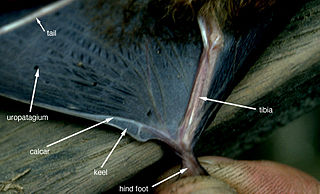
Ascomycota is a phylum of the kingdom Fungi that, together with the Basidiomycota, forms the subkingdom Dikarya. Its members are commonly known as the sac fungi or ascomycetes. It is the largest phylum of Fungi, with over 64,000 species. The defining feature of this fungal group is the "ascus", a microscopic sexual structure in which nonmotile spores, called ascospores, are formed. However, some species of the Ascomycota are asexual, meaning that they do not have a sexual cycle and thus do not form asci or ascospores. Familiar examples of sac fungi include morels, truffles, brewers' and bakers' yeast, dead man's fingers, and cup fungi. The fungal symbionts in the majority of lichens such as Cladonia belong to the Ascomycota.

Amniotes belong to the clade Amniota, a clade of tetrapod vertebrates that comprises sauropsids and synapsids. They are distinguished from the other living tetrapod clade—the lissamphibians—by the development of three extraembryonic membranes, thicker and more keratinized skin, and costal respiration.

Cheilostomatida, also called Cheilostomata, is an order of Bryozoa in the class Gymnolaemata.

Membraniporidae is a bryozoan family in the order Cheilostomatida. Membranipora form encrusting or erect colonies; they are unilaminar or bilaminar and weakly to well-calcified. Zooids have vertical and basal calcified walls, but virtually no frontal calcified wall: most of the frontal surface is occupied by frontal membrane. An intertentacular organ is also present. The larvae are not brooded. The ancestrula is generally twinned. Kenozooids may be present in a few species; modified zooids analogous to avicularia are rare.

Ostracods, or ostracodes, are a class of the Crustacea, sometimes known as seed shrimp. Some 33,000 species have been identified, grouped into 7 valid orders. They are small crustaceans, typically around 1 mm (0.04 in) in size, but varying from 0.2 to 30 mm in the case of the marine Gigantocypris. The largest known freshwater species is Megalocypris princeps, which reach 8mm in length). In most cases, their bodies are flattened from side to side and protected by a bivalve-like valve or "shell" made of chitin, and often calcium carbonate. The family Entocytheridae and many planktonic forms do not have calcium carbonate. The hinge of the two valves is in the upper (dorsal) region of the body. Ostracods are grouped together based on shell and soft part morphology. While early work indicated the group may not be monophyletic and early molecular phylogeny was ambiguous on this front, recent combined analyses of molecular and morphological data suggested monophyly in analyses with broadest taxon sampling, but this monophyly had no or very little support. They have a wide range of diets, and the class includes carnivores, herbivores, scavengers and filter feeders, but most ostracods are deposit feeders.

The Schizophora are a section of true flies containing 78 families, which are collectively referred to as muscoids, although technically the term "muscoid" should be limited to flies in the superfamily Muscoidea; this is an example of informal, historical usage persisting in the vernacular. The section is divided into two subsections, the Acalyptratae and Calyptratae, which are commonly referred to as acalyptrate muscoids and calyptrate muscoids, respectively.

Isopoda is an order of crustaceans that includes woodlice and their relatives. Isopods live in the sea, in fresh water, or on land. All have rigid, segmented exoskeletons, two pairs of antennae, seven pairs of jointed limbs on the thorax, and five pairs of branching appendages on the abdomen that are used in respiration. Females brood their young in a pouch under their thorax.

The Phacopina comprise a suborder of the trilobite order Phacopida. Species belonging to the Phacopina lived from the Lower Ordovician (Tremadocian) through the end of the Upper Devonian (Famennian). The one unique feature that distinguishes Phacopina from all other trilobites are the very large, separately set lenses without a common cornea of the compound eye.

The tympanic cavity is a small cavity surrounding the bones of the middle ear. Within it sit the ossicles, three small bones that transmit vibrations used in the detection of sound.

Cyclostomatida, or cyclostomata, are an ancient order of stenolaemate bryozoans which first appeared in the Lower Ordovician. It consists of 7+ suborders, 59+ families, 373+ genera, and 666+ species. The cyclostome bryozoans were dominant in the Mesozoic; since that era, they have decreased. Currently, cyclostomes seldom constitute more than 20% of the species recorded in regional bryozoan faunas.

Stylommatophora is an order of air-breathing land snails and slugs, terrestrial pulmonate gastropod molluscs. This taxon includes most land snails and slugs. Stylommatophorans lack an operculum, but some close their shell apertures with temporary "operculum" (epiphragm) made of calcified mucus. They have two pairs of rectractile tentacles, of which the upper pair bears eyes on the tentacle tips. All stylommatophorans are hermaphrodites.
In mycology a tissue or feature is said to be amyloid if it has a positive amyloid reaction when subjected to a crude chemical test using iodine as an ingredient of either Melzer's reagent or Lugol's solution, producing a blue to blue-black staining. The term "amyloid" is derived from the Latin amyloideus ("starch-like"). It refers to the fact that starch gives a similar reaction, also called an amyloid reaction. The test can be on microscopic features, such as spore walls or hyphal walls, or the apical apparatus or entire ascus wall of an ascus, or be a macroscopic reaction on tissue where a drop of the reagent is applied. Negative reactions, called inamyloid or nonamyloid, are for structures that remain pale yellow-brown or clear. A reaction producing a deep reddish to reddish-brown staining is either termed a dextrinoid reaction or a hemiamyloid reaction.

The calcar, also known as the calcaneum, is the name given to a spur of cartilage arising from inner side of ankle and running along part of outer interfemoral membrane in bats, as well as to a similar spur on the legs of some arthropods.
The ascus is a diagnostic morphological feature of the bryozoan suborder Ascophora. It is a water-filled sac of frontal membrane opening (ascopore) at or near the zooid orifice. It functions as a hydrostatic system by allowing water into the space below the inflexible, calcified frontal wall when the zooid everts its polypide by muscles pulling the frontal membrane inwards. The ascus, along with a calcified frontal shield, define ascophoran bryozoa.

Flustrina is a suborder under the order Cheilostomatida of gymnolaematan Bryozoa.
The avicularium in cheilostome bryozoans is a modified, non-feeding zooid. The operculum, which normally closes the orifice when the zooids tentacles are retracted, has been modified to become a mandible. Strong muscles operate it. The polypide is greatly reduced, and the individual receives nourishment from neighboring zooids. The shape of the avicularian zooid can be identical to the feeding autozooid, but is usually elongated in the direction of the mandible.

The Cribrilinidae family is a part of the suborder Ascophora within the bryozoans. They are characterized by numerous spinose ribs (costae) overarching the frontal membrane of each zooid.

The Olenelloidea are a superfamily of trilobites, a group of extinct marine arthropods. They lived during the late Lower Cambrian and species occurred on all paleocontinents.

The Enthemonae is a suborder of sea anemones in the order Actiniaria. It comprises those sea anemones with typical arrangement of mesenteries for actiniarians.
Callopora lineata is a species of colonial bryozoan in the family Calloporidae. It is found on rocky shores in the Atlantic Ocean and the Mediterranean Sea.
















